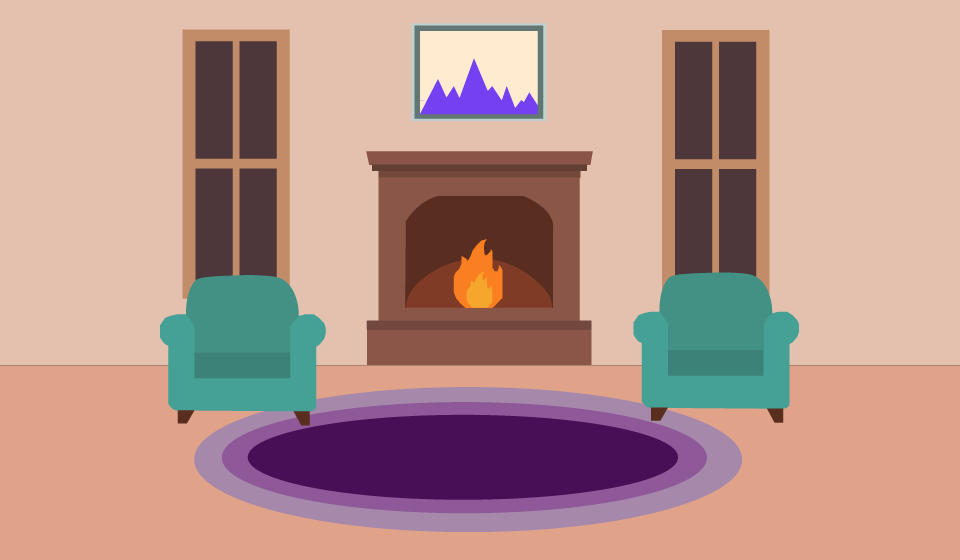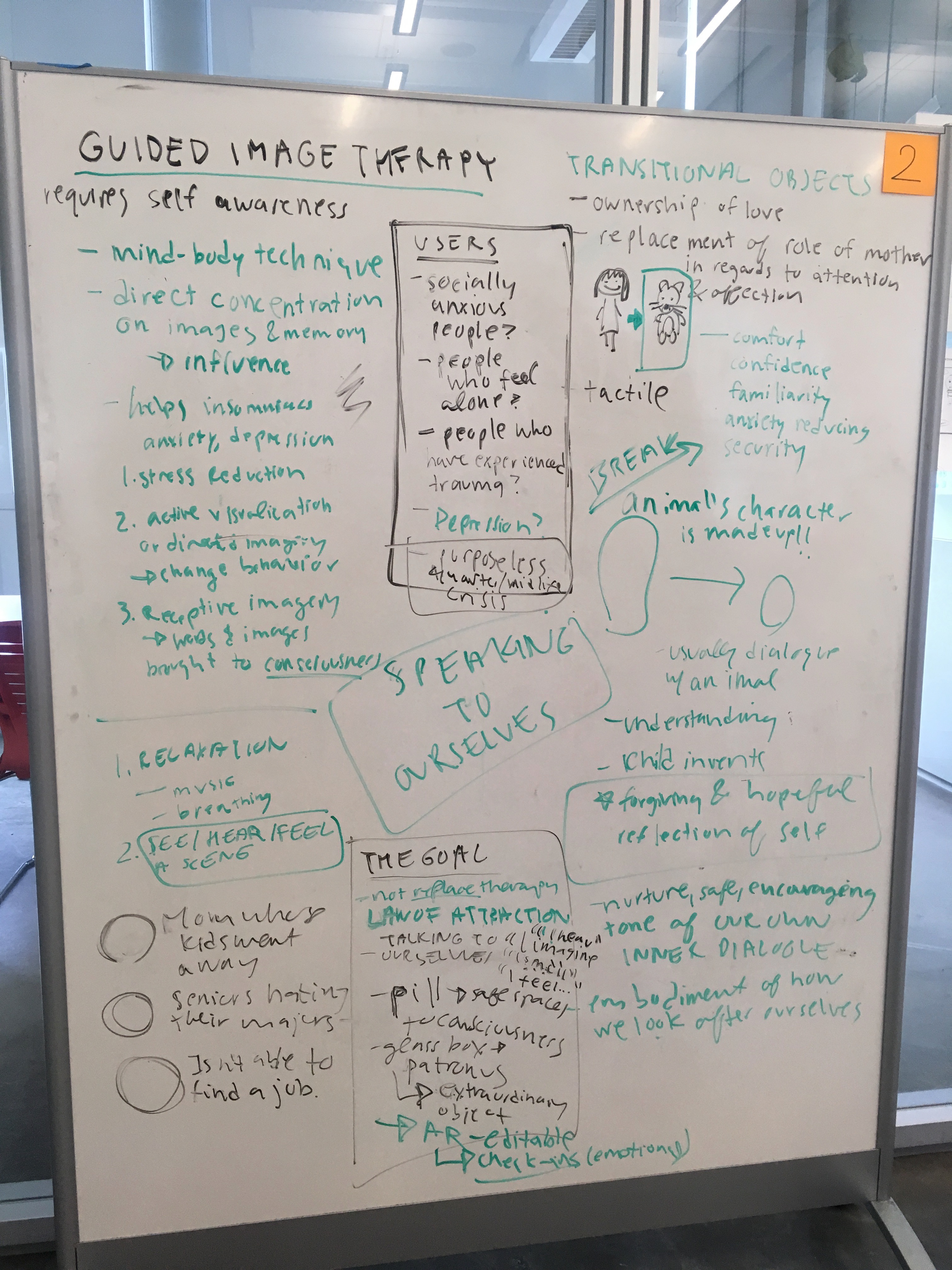VRoom: Speculative VR Safe Space
VRoom is a speculative virtual reality application which allows the user to experience a safe space whenever they need it, and which helps guide the user in becoming the person they wish to be. This was a deliberately speculative class project that I worked on in a group of three other designers over two weeks. Due to the short time frame and speculative nature of this project, we were not able to create a high fidelity prototype. Instead, we used illustrations to describe the application. The illustrations throughout this page are my own.

Framing the Problem
At a competitive school like UC Berkeley, mental health is a major issue. While there are services available, often times, it is not enough due to the large student population. My teammates and I wanted to use our design skills to see what we could come up with to help with such issues.
Because we are not mental health experts, we decided to focus on everyday issues that could impact mental health, rather than mental illnesses such as depression and anxiety. One such area is how people deal with roadblocks in general. During early discussions, we came to the realization that how people deal with obstacles is likely due to their pasts. As such, we were interested in determining through interviews how people's pasts affect their present.
User Research
We chose to each interview one person (4 people total) in their 20s-30s about key objects and memories from their childhoods. We asked them to recall a key memory or object from their childhood and asked them a series of questions about how they thought it affected their current life. We also asked them about their current habits and how they overcome obstacles. Across all interviewees, we found common themes of transitional objects and issues of confidence.
Directed Background Research
After interviewing 4 people, we found that although there were some common themes, it was hard to figure out the answer to our initial research question. After all, lives are complicated. There may be many other reasons why people are the way they are that they themselves are not cognizant of. In order to augment our user interviews, we decided to do some online research relating to issues of confidence and transitional objects.
Here are the main topics we looked into.
Transitional Objects: Objects that children carry around with them to comfort themselves in difficult or unusual times. In our user interviews, these were the "key objects" that we asked about. Some of these objects included stuffed animals or something that they received when they were younger. Our interviewees still keep these items close at hand.
Guided Image Therapy: A therapy method used to direct one's concentration into visualizing a place or situation where one feels the most comfortable. It is mainly used to reduce stress and influence one's own behavior towards the positive. This would be useful in helping with issues of confidence and can also be done without help from a therapist if needed.
Law of Attraction: The idea that we attract whatever we think about, both in the positive and negative sense. In the positive case, one is able to achieve success by believing that oneself can be successful. Again, this could help with issues of confidence.
Ideation
Based on our user research and directed background research, we had a brainstorming session.

Some of the key ideas that we had include:
- A patch that the user can upload their pictures and memories on to and put on a stuffed animal (or other sentimental object), forming their own "extraordinary object"
- A support/social network to destigmatize the stressors of life and reaching out for help
- A customized VR safe space that the user can visit to boost their feelings of confidence
Competitor Research
Next, we decided to research on possible competitors/already existing products. We found that as standalone ideas, many of our ideas have already existing products associated with them. Therefore, we decided to combine some of our ideas.
Solution
VRoom is a VR application which allows the user to create their safe space, or the place where they feel the most safe/calm and their vision space, or their ideal life trajectory. The user can customize their space, and an avatar (which represents a transitional object) ushers the user through guided image therapy.
User Flow/Storyboard
In order to think through the interactions for the VR system, we created a story board. The user starts in an empty white room, and is guided through stages we named Creation, Reflection, Clarity, and Vision.
Creation
The user is prompted to think about a place that makes them happy. They are given options to customize the VR space based on that place, and the empty white room is transformed into a personalized safe space.

Reflection
The user is prompted to think about and describe their feelings, and what brought them to the safe space. Within the VR space, the user is guided by a genderless avatar that listens to the user and provides feedback. This avatar would likely be a real-life therapist.

Clarity
The user is prompted through multiple thought-provoking questions to help the user gain better understanding of where they are and what they can do to reach their ideal self/life. Here, the user wants to be a CEO. With the guidance of the avatar's question, she takes stock of who she is (such as weaknesses and strengths), and the avatar suggests what she may want to do.

Vision
The user realizes what they should do to achieve the change they want after going through several clarity sessions. They will use the app to create a list of things they need to acheive their goals. This is their vision space.

Next Steps
The next step would be to make a VR prototype for user testing purposes. Because VR is an abstract experience, there is only so much our illustrations can explain about the application.
For a low-medium prototype, we could have a pre-set safe space (i.e. they can choose options of location but not necessarily customize). Then one of us could ask the questions the avatar would ask.
Additionally, because this was a speculative project, there was a lot that we abstracted away. One of the details is the avatar. Because we are not mental health experts, we could not create our own questions for the avatar to use beyond surface level questions. In order to create an accurate prototype, we would need to do some research or consult with a real-life therapist. We also abstracted out the "customization" feature. This would probably require a lot of development, and for prototyping, we would need to create a lot of VR assets.
If I were going to create a product out of this, I would probably split the product into only "safe space". In this case, the app would be mostly meditation and mindfulness. However, several of these types of apps already exist, so especially without being able to show how the VR space can be customized, it may be tricky.